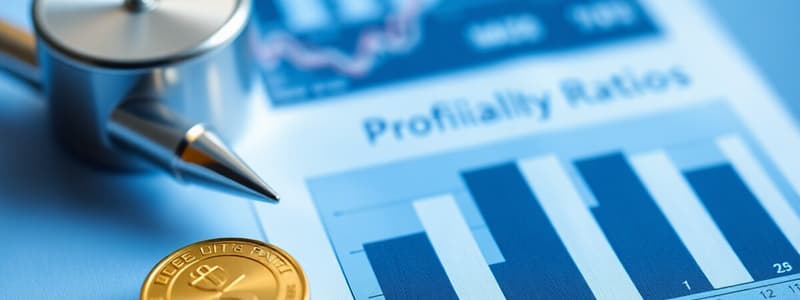Podcast
Questions and Answers
How is the average receivables calculated?
How is the average receivables calculated?
- Sum of opening and closing receivables divided by 2 (correct)
- Closing receivables multiplied by 2
- Closing receivables plus the average sales
- Total sales divided by total expenses
What does the creditor settlement period refer to?
What does the creditor settlement period refer to?
- The total time taken to collect receivables
- The duration until accounts become overdue
- The time taken to pay off suppliers after purchase (correct)
- The average time for inventory turnover
What key ratio indicates how many times a business can cover its interest repayments?
What key ratio indicates how many times a business can cover its interest repayments?
- Current ratio
- Liquidity ratio
- Interest cover (correct)
- Gearing ratio
Which formula would you use to calculate the working capital ratio?
Which formula would you use to calculate the working capital ratio?
What do liquidity ratios primarily assess?
What do liquidity ratios primarily assess?
What does the Return on Shareholders Capital Employed measure?
What does the Return on Shareholders Capital Employed measure?
Which of the following formulas represents the Net Profit Margin?
Which of the following formulas represents the Net Profit Margin?
What does the Gross Profit Margin indicate?
What does the Gross Profit Margin indicate?
What is included in the calculation of Return on Total Capital Employed?
What is included in the calculation of Return on Total Capital Employed?
Which financial ratio is calculated as Inventory usage / holding period?
Which financial ratio is calculated as Inventory usage / holding period?
What does the Receivables/Debtors Settlement Period measure?
What does the Receivables/Debtors Settlement Period measure?
In the context of profitability ratios, what do expense ratios assess?
In the context of profitability ratios, what do expense ratios assess?
Which of the following represents the formula for calculating gross profit?
Which of the following represents the formula for calculating gross profit?
Flashcards
Return on Shareholders Capital Employed
Return on Shareholders Capital Employed
Measures the return generated by each pound of shareholder investment.
Return on Total Capital Employed
Return on Total Capital Employed
Calculates the overall return generated by all sources of funding, including debt and equity.
Gross Profit Margin
Gross Profit Margin
Indicates the percentage of revenue retained as gross profit after accounting for direct costs.
Net Profit Margin
Net Profit Margin
Signup and view all the flashcards
Inventory Turnover
Inventory Turnover
Signup and view all the flashcards
Receivables/Debtors Settlement Period
Receivables/Debtors Settlement Period
Signup and view all the flashcards
Selling and Distribution Cost Ratio
Selling and Distribution Cost Ratio
Signup and view all the flashcards
Administrative Expenses Ratio
Administrative Expenses Ratio
Signup and view all the flashcards
Receivables Settlement Period
Receivables Settlement Period
Signup and view all the flashcards
Payables Settlement Period
Payables Settlement Period
Signup and view all the flashcards
Acid Test Ratio
Acid Test Ratio
Signup and view all the flashcards
Gearing Ratio
Gearing Ratio
Signup and view all the flashcards
Interest Cover Ratio
Interest Cover Ratio
Signup and view all the flashcards
Study Notes
Profitability Ratios
-
Return on Shareholders' Capital Employed (ROSCE): Measures return generated based on shareholder investment. Calculated as (Net profit before interest & tax * 100) / Total Shareholders' Funds (exclude revaluation reserve).
-
Return on Total Capital Employed (ROCE): Measures return generated using all funding sources (debt and equity). Calculated as (Net profit before interest & tax * 100) / Total Capital Employed (long-term funds + equity + borrowings/debt).
-
Gross Profit Margin: Return based on cost of sales. Calculated as (Gross Profit * 100) / Revenue.
-
Net Profit Margin: Return after deducting all indirect costs. Calculated as (Net profit before interest & tax * 100) / Revenue.
Expense Ratios
-
Selling and Distribution Costs Ratio: Percentage of revenue spent on selling and distribution. Calculated as (Selling and distribution costs * 100) / Revenue.
-
Administrative Expenses Ratio: Percentage of revenue spent on administration. Calculated as (Administrative expenses * 100) / Revenue.
Operating Ratios
-
Inventory Usage/Holding Period: Measures the time inventory remains in stock. Calculated as (Closing Inventory * 365) / Cost of Sales. Alternatively, calculate as (Average Inventory*365)/Cost of Sales using average inventory calculated as (Opening Inventory + Closing Inventory)/2.
-
Receivables/Debtors Settlement Period: Measures the time it takes to collect on credit sales. Calculated as (Closing Receivables * 365) / Revenue; alternatively use average receivables [(Opening Receivables + Closing Receivables)/2].
-
Payables/Creditors Settlement Period: Measures the time it takes to pay suppliers. Calculated as (Closing Payables * 365) / ((Purchases + Closing Payables - Opening Payables)/2).
Liquidity Ratios
-
Working Capital Ratio: Measures short-term liquidity. Calculated as Current Assets / Current Liabilities. Expresses the ratio as x:1.
-
Acid Test Ratio: Measures quick liquidity (excludes inventory). Calculated as (Liquid Assets / Current Liabilities) and is expressed as x:1
Gearing/Leverage Ratios
- Gearing Ratio: Measures percentage of funding from debt to long-term debt and equity. Calculated as (Long-term liabilities * 100) / Total Capital Employed.
Other Ratios
- Interest Cover: Indicates how many times earnings can cover interest payments. Calculated as Profit Before Interest & Tax / Interest Payable.
Studying That Suits You
Use AI to generate personalized quizzes and flashcards to suit your learning preferences.




